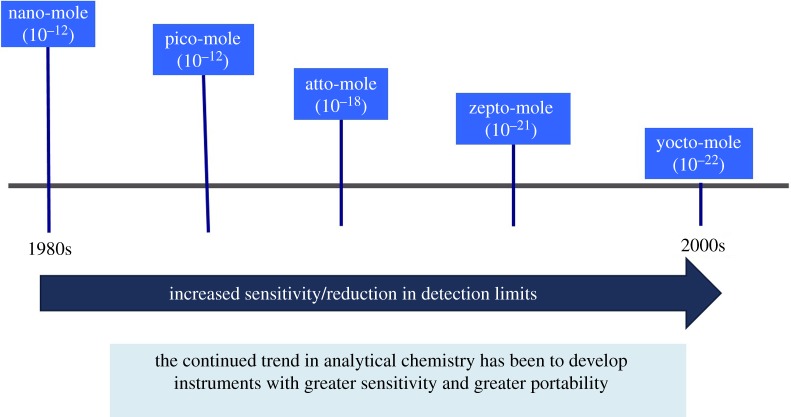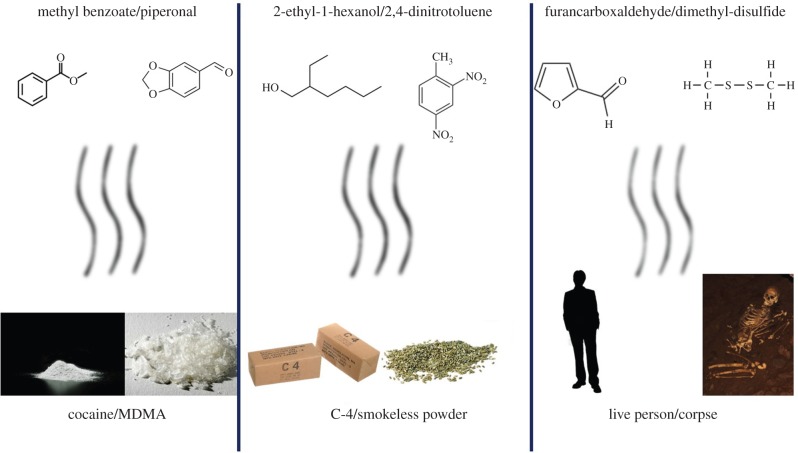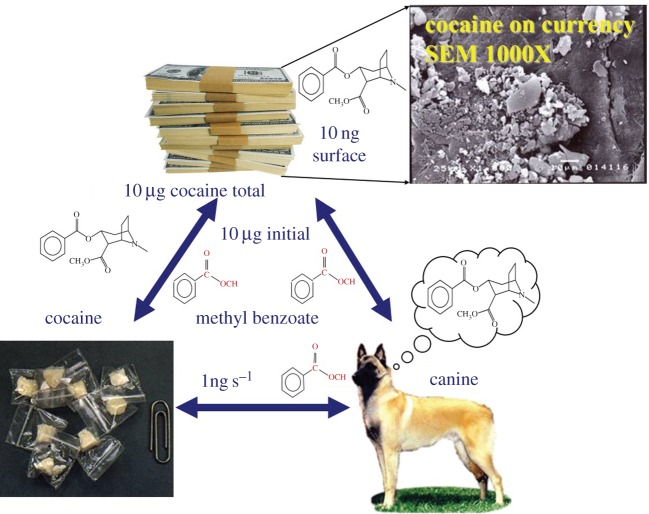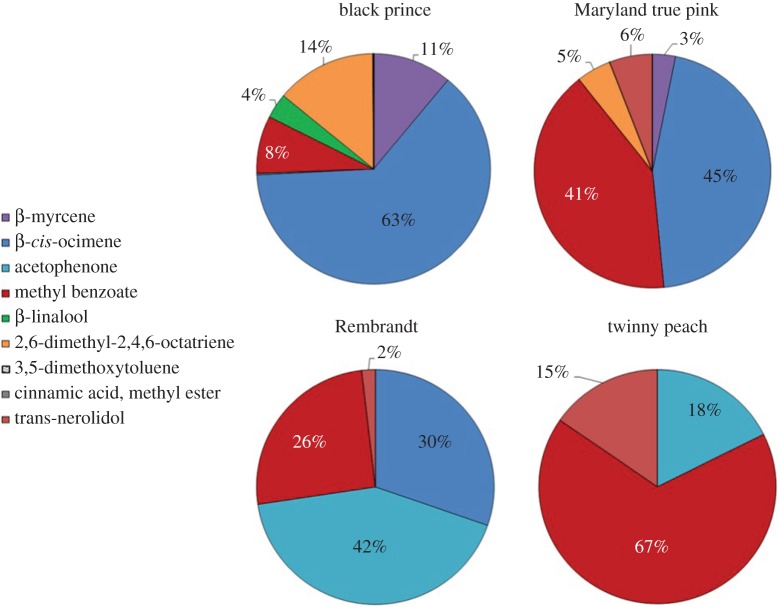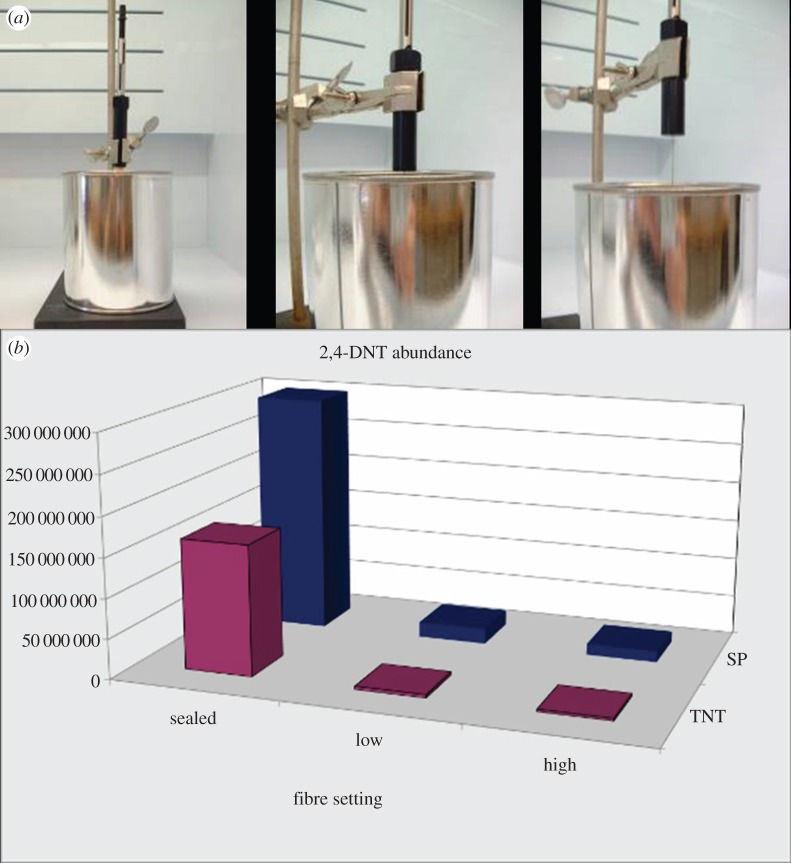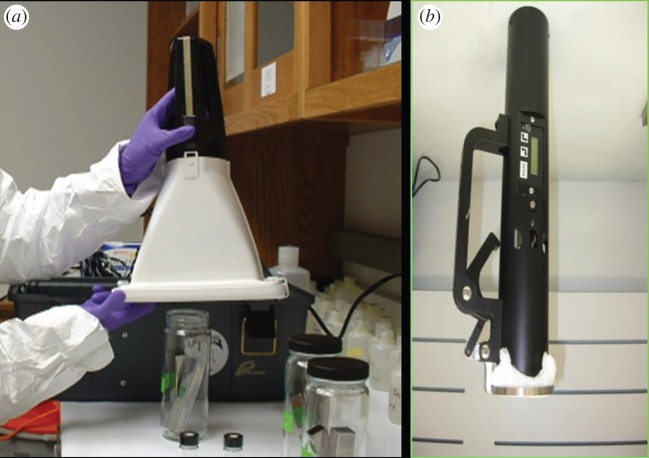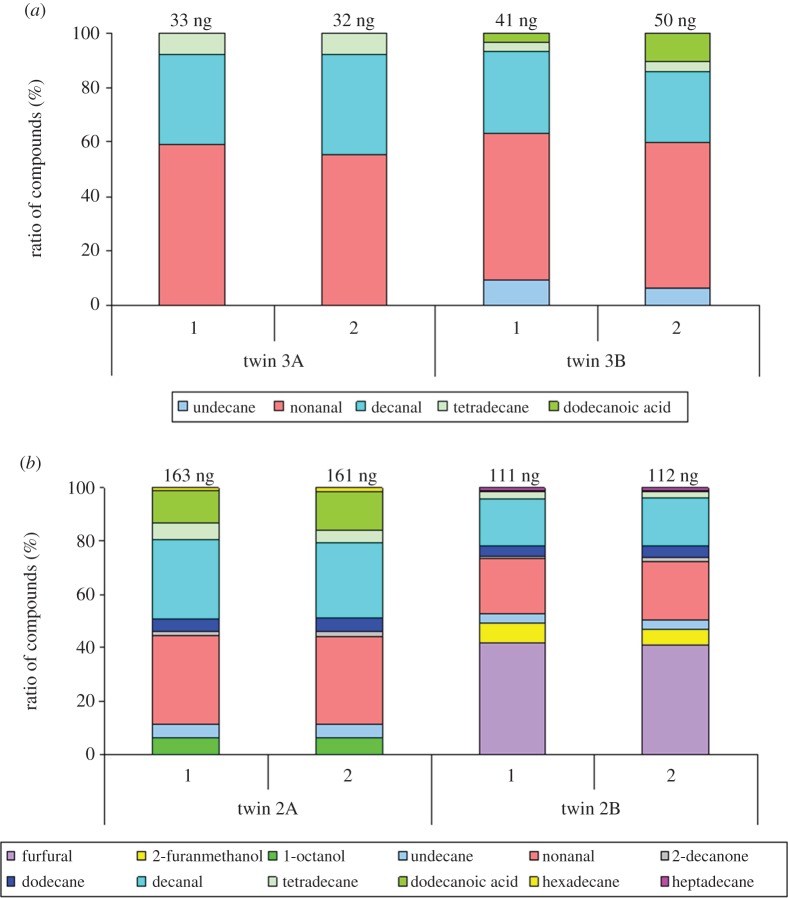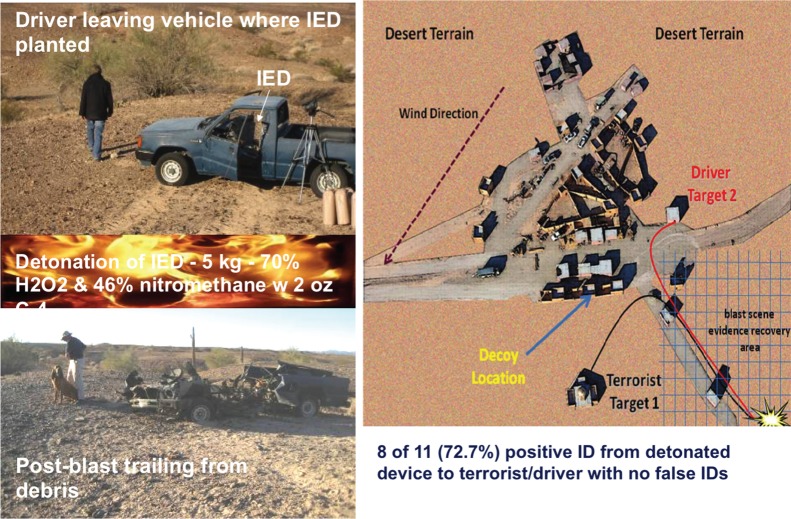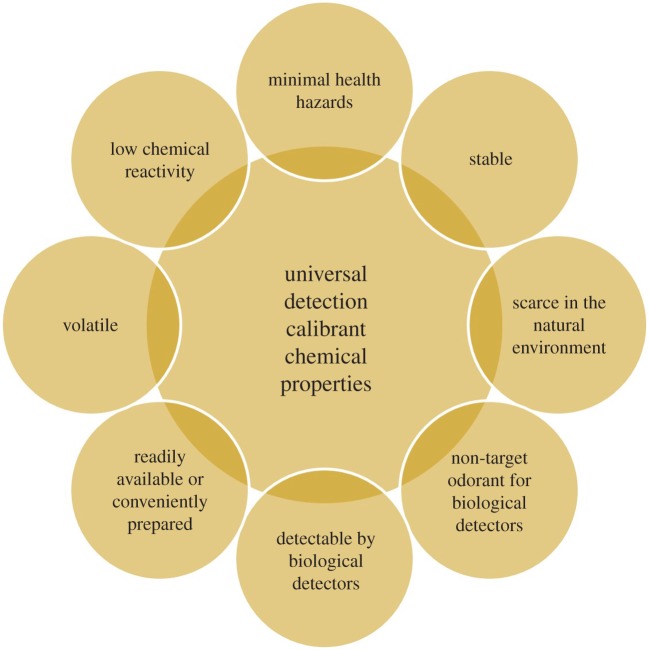Abstract
This paper explores the advances made in identifying trace amounts of volatile organic compounds (VOCs) that originate from forensic specimens, such as drugs, explosives, live human scent and the scent of death, as well as the probative value for detecting such odours. The ability to locate and identify the VOCs liberated from or left by forensic substances is of increasing importance to criminal investigations as it can indicate the presence of contraband and/or associate an individual to a particular location or object. Although instruments have improved significantly in recent decades—with sensitivities now rivalling that of biological detectors—it is widely recognized that canines are generally still more superior for the detection of odourants due to their speed, versatility, ruggedness and discriminating power. Through advancements in the detection of VOCs, as well as increased standardization efforts for instruments and canines, the reliability of odour as evidence has continuously improved and is likely to continue to do so. Moreover, several legal cases in which this novel form of evidence has been accepted into US courts of law are discussed. As the development and implementation of best practice guidelines for canines and instruments increase, their reliability in detecting VOCs of interest should continue to improve, expanding the use of odour as an acceptable form of forensic evidence.
Keywords: forensic science, detection canines, explosives, drugs, human scent, human remains
1. Introduction
Forensic science can be defined as the application of any form of science, in particular analytical chemistry, where ‘the trace, which, by definition, is a pattern, a signal or material transferred during an event (often unknowingly by the actors of the event)’ is analysed and accepted as a form of scientific evidence into a civil or criminal proceeding [1,2]. It is for this reason that knowledge and technology obtained through a sound scientific method should not only meet good scientific practice, but should also comply with the rules of admissibility that are set forth by the relevant courts of law. Overall, science alone may not have the ability to provide definitive solutions, but it can offer increasingly accurate and objective information generating investigative leads, as well as assisting a judge/jury in determining the truth and allowing for justice to be achieved. It is for this reason that there is a necessity for continued scientific advancement with respect to forensic investigations.
For more than a century, fingerprint evidence was recognized as the gold standard in forensic science. It was in 1880 that Henry Faulds of Scotland published his seminal paper proposing the use of fingerprints to identify an individual and, in particular, suggested that the skin-ridge patterns could be used to connect an offender to a crime scene [3]. Simultaneously, another cost-effective, real-time detection tool that was being employed by law enforcement officials, owing to its reliability, versatility and speed, was the use of canines (Canis familiaris) [4]. The use of canines in criminal investigations dates as far back as the use of fingerprints. The English used bloodhounds while searching for Jack the Ripper in 1888 and in 1893 the state Supreme Court of Alabama (US) acknowledged that ‘dogs may be trained to follow the tracks of a human being with considerable certainty and accuracy’ [5]. The courts ruled that the testimony regarding the tracking performance of a canine can be presented to the jury, along with other evidence, as a means to connect the defendant to the crime. Since then, canines have been continuously employed for the detection of humans, drugs, explosives and human remains because of their high selectivity and sensitivity towards locating odours. While the canine's olfaction system is widely relied upon, the system itself is not completely understood, but it is known that, like humans, canines have receptor cells that can detect a compound(s), and olfactory nerves that carry the signals that are interpreted by the brain, allowing for the identity of the odourant to be determined [6]. Unlike humans, however, the canine olfactory system constitutes a much larger portion of its biology, with 50% of the internal nasal area containing olfactory sensory cells and nearly one-eighth of a canine's brain being dedicated to olfaction. While the average person has some 5 million olfactory sensory cells, common detection canines, such as German Shepherd dogs, have 220 million olfactory sensory cells, indicating that a canine's olfactory abilities are at least 44 times greater than that of humans [7]. Moreover, canines have approximately 1300 genes in their olfactory repertoire, which is nearly 20 times more than that of humans, providing them with the ability to be trained on various types of odours with a high degree of sensitivity and discriminating power [8]. Over the years, attempts have been made to develop various forms of technology and instrumentation for on-site detection and screening of VOCs, yet none to date has been capable of replicating the combination of selectivity, sensitivity and field versatility demonstrated by canines, which is why they are currently and widely recognized as the gold standard for the field detection of VOCs [6]. This paper highlights the advancements made in analytical chemistry, specifically focusing on the detection of VOCs released from different forensic specimens, the relevance of these specimens to canines and the increased application of odour as a form of forensic evidence.
2. Analytical techniques for the analysis of volatile organic compounds
The sensitivity reported for analytical instruments has improved dramatically in recent decades, as seen in figure 1: limits of detection were reported at the nano-mole (10−9) level just two decades ago; today these values are at the yocto-mole (10−22) level [9]. In addition to increasingly lower detection limits, many of these instruments have rapid analysis times, and have become miniaturized and portable. These capabilities have not only allowed for the improved detection of trace evidence, but also have permitted the potential detection of residual odours associated with forensic specimens that have since been removed or are hidden from view. Prior to the development of these new instrumental methods, forensic-related VOCs were only detectable by trained canines, but now with these techniques, compounds of interest may be detected without or in conjunction with canine responses. Over the years, dozens of orthogonal detection techniques have been developed and deployed with a representation of some shown in figure 2 [10]. Of these instruments, ion mobility spectrometry (IMS) is by far the most widely used analytical instrument to detect forensic traces (primarily drugs and explosives) in the field, with over 50 000 units installed and used globally [11]. IMS relies on the difference in movement (mobility) of ions under the influence of an applied electric field. The technique creates ions using radioactive isotopes, like that of 241Am or 63Ni, and as a result can operate under ambient conditions, eliminating the need for a vacuum as is found with other techniques, such as mass spectrometry [12]. This makes IMS inexpensive, relatively lightweight (a typical unit weighs approx. 45 pounds) and field portable [13]. However, low discrimination capabilities coupled with the inability to be used continuously (low duty cycles) have limited the use of IMS. Other techniques, including fluorescent detection and miniature mass spectrometry, have also been deployed. Fluorescent detection relies on the fact that specially designed fluorescent polymers are quenched when they combine with explosive compounds, a technique championed by Timothy Swager [14]. This has allowed for hand-held (weighing approx. 3 pounds), commercially available, off-the-shelf vapour devices that can be used for the detection of explosive materials. These fluorescent detectors are highly specific and sensitive, but suffer from over saturation of the detector causing low duty cycles and have a narrow list of compounds that they are able to detect. Mass spectrometry, on the other hand, does provide the specificity that IMS lacks and is able to detect a much wider variety of compounds than fluorescent detection. Although mass spectrometry does require sophisticated pumping mechanisms to provide vacuum, technology has advanced to the point where these devices are field transportable and are able to run on battery power [15]. These instruments often boast low detection limits, nano-gram to pico-gram range for some explosives for the miniature mass spectrometer and mid to low pico-gram range for the IMS and fluorescent detector; however, these instruments fall short in comparison with biological detectors such as canines, which are less expensive and have the dual ability to detect the odour and follow the odour plume to its source autonomously. This capability of canines saves valuable time in identifying clandestine threats, such as explosives, in locating narcotics that are hidden and in locating humans.
Figure 1.
Reported improvement in instrument sensitivity over time. (Online version in colour.)
Figure 2.
Diagram showing various electronic and biological sensors [10]. (Online version in colour.)
The discriminating power of a canine is highly advantageous with the ability to be trained on numerous odours quickly and with a high degree of reliability, with typical correct responses generally greater than 90% and false alert rates below 10%, even in challenging environments with noisy chemical backgrounds [16]. Additionally, it has been demonstrated that canines, typically, do not respond to the target substance themselves, but rather to the odourants associated with the substance. This finding highlights the importance of investigating the VOCs released from forensic specimens and those odourants that elicit a canine alert [10,17]. One of the most widely employed techniques used to identify and quantify VOCs in various areas of applied chemistry (e.g. environmental, food, personal care and forensic science) is solid-phase microextraction (SPME) as it encompasses several advantages, such as being non-exhaustive, relatively simple to use, portable, rapid and inexpensive [18–20]. Physically, it can best be described as a short, thin, fused silica solid, coated with a selective polymer, which ranges in thickness from 7 to 100 µm, and is protected by a metal sheath when not in use. SPME is generally used with separation methods including high performance liquid chromatography (HPLC) and liquid chromatography–mass spectrometry (LC-MS); however, the majority of studies, particularly in forensic science, have used gas chromatography–mass spectrometry (GC-MS) for the analysis of compounds that have sufficient volatility and thermal stability [18].
3. Analysis of volatile organic compounds released from various types of forensic specimens
(a). Narcotics
Research on the VOCs released from different types of illicit materials has revealed that the liberated compounds often differ from the target substance itself [10,21]. For instance, studies performed on cocaine found that methyl benzoate, a by-product of cocaine, was the active odourant (the VOC causing the canine to alert) and may be used as a reliable indicator for the presence of cocaine (figure 3) [17].
Figure 3.
Common VOCs detected from drugs, explosives and live humans, as well as those who are deceased. (Online version in colour.)
In recent decades, numerous reports have demonstrated that the majority of paper currency in circulation throughout the world is contaminated with microscopic traces of cocaine typically in the microgram range. One such study reported that most currency in circulation in the USA was contaminated with, on average, 14.5 µg of cocaine owing to its association with drug trafficking [22]. This finding led to the question—could a narcotics detection canine positively alert to the amount of cocaine found on circulated currency? Studies demonstrated that the levels of cocaine and methyl benzoate present on circulated currency were not likely to elicit a response from a narcotics detection canine. This is because it was discovered that in order to obtain a positive response from a majority of narcotics detection canines, microgram levels of methyl benzoate needed to be present on the surface of the currency, or emanating at a nano-gram level [21]. Instances in which currency elicited a positive canine alert have been presented in several different US courts as a form of corroborating evidence that the currency in question was likely to be associated with illicit drugs [23]. Figure 4 shows the reported levels of cocaine typically found on the surface of US currency, as well as the total amount of cocaine present. Additionally, the levels of methyl benzoate needed to elicit a positive alert by narcotics detection canines are also presented [21].
Figure 4.
Diagram showing the amount of cocaine and methyl benzoate found on or released from currency demonstrated to elicit positive responses from drug detection canines. (Online version in colour.)
Upon identifying the active odourant of a forensic specimen, it is important to determine if these compounds are present, to any significant extent, in the environment. In a recent US Supreme Court case, State of Florida v. Jardines, the issue of the cocaine odourant, methyl benzoate, also being reported in other substances was raised. In this case, the police received an anonymous tip that marijuana was being grown at the residence of Mr Joelis Jardines. A detective arrived to the scene with his narcotic detection canine which alerted at the base of Jardines' front door. As a result of the canine alert, a search warrant was obtained and upon searching the residence, 179 marijuana plants were discovered. Following the arrest, the defense sought to suppress the evidence seized from the residence, claiming that the use of a detection canine at the doorstep of a private residence is an illegal search and a violation of the Fourth Amendment of the US Constitution, which prohibits unlawful search and seizure [24,25]. An amici curiae brief stated that as canines are scientifically proven to alert to an active signature odour of the contraband and not the contraband itself, a canine's accuracy should be called into question because certain active odours were found in common household items. Specifically, methyl benzoate, the active odour of cocaine, has been reported to be a major VOC produced by snapdragon flowers (Antirrhinums) [26,27]. A recent study was performed to determine if flowers containing methyl benzoate could elicit a positive response from narcotics detection canines.
Four types of snapdragon flowers were grown and tested using headspace SPME/GC-MS, and their odour profiles were determined at various stages of the plant's life cycle. The results revealed that, overall, the early stages of the plant's life cycle produced a greater abundance of methyl benzoate, but it was also discovered that other compounds contributed more to the snapdragon's signature odour profile than did methyl benzoate, as seen in figure 5. Additionally, two types of canine trials were performed to determine if the snapdragon flowers would elicit a response from specially trained narcotics detection canines. The flowers represented 1 µg of methyl benzoate, an amount that was determined to be well above the cited detection limit of specially trained canines for methyl benzoate [21]. For the second trial, a single blind test was performed by hiding cut snapdragon flowers, a soil sample (blank) and 15–20 g of cocaine (a positive control). Multiple runs, with 20 canines, were performed and it was discovered that none of the snapdragon flowers (potted and cut) elicited a canine response, whereas they all alerted to the positive control [28].
Figure 5.
Distribution of the VOCs released from snapdragon flowers evaluated [28]. (Online version in colour.)
The capabilities of narcotic detection canines were also brought into question in the US Supreme Court case the State of Florida v. Harris [29]. This case involved a detection canine that positively alerted to Clayton Harris' vehicle, providing officers with probable cause to perform a search. Harris was subsequently arrested for possession of ingredients to make methamphetamine after it was discovered in his car during the search. The defense moved to suppress the seized evidence on the grounds that the canine was ‘insufficiently reliable to provide a basis for probable cause to search the vehicle’ [30]. The judgement was later reversed by the US Supreme Court. Justice Kagan delivered the opinion for the unanimous court, citing the Scientific Working Group on Dog and Orthogonal Detector Guidelines (SWGDOG), in which she stated ‘the better measure of a dog's reliability thus comes away from the field, in controlled testing environments [3]. For that reason, evidence of a dog's satisfactory performance in a certification or training program can itself provide sufficient reason to trust his alert. If a bona fide organization has certified a dog after testing his reliability in a controlled setting … the dog's alert provides probable cause to search, using a totality-of-the-circumstances' [29]. In the case of Harris, the reliability that stems from a bona fide organization is also addressed on multiple levels, local, state and federal, to ensure that such evidence is trustworthy and compliant. Therefore, to improve and maintain the performance of detection canines and by extension the reliability of any evidence that is discovered, it is important that consistent protocols are followed and that proper training aids be used.
To improve the reliability of canines in the field and their acceptance in the courts, researchers have been conducting studies focused on improving the availability of reliable canine training aids including developing odour mimics. These odour mimics can allow for training to be performed with non-controlled materials instead of the actual illicit substances [31–33]. The need to possess actual illicit substances can be challenging for some trainers/organizations in order to adhere to various licensing and regulatory guidelines required to maintain possession of these controlled substances. Liability issues may also arise if these substances are misplaced and/or damaged during routine training. By identifying the active odourant of a target substance, mimics can be created which can reduce these restrictions.
Identification of active odourant(s) is a critical step in creating non-controlled odour mimics, and also important for field deployment is the ability to have these training aid mimics to release a consistent and known amount of the active odour over an extended period of time. A technology, known as Controlled Odor Mimic Permeation Systems (COMPS) contains the active odourant stored within a permeable, polymer bag allowing for the active odour to permeate at a controlled rate, making the delivery system more reliable and reproducible than traditional training aids [34,35]. Additionally, COMPS is field rugged and can be used repeatedly with minimal degradation, eliminating the restrictions and liability issues associated with using real, controlled canine training aids. Moreover, the dissipation rate of an active odourant can be manipulated by changing parameters, such as the type of polymer bag used and/or the polymer thickness.
Macias et al. [32] employed COMPS when assessing the canine detectability and threshold of piperonal, the active odourant of 3,4-methylenedioxy-N-methylamphetamine (MDMA or ecstasy). To determine if a canine will alert to the illicit substance, un-trained (green) canines were imprinted with piperonal and then evaluated using the actual illicit material (MDMA). During the course of the training, which took place twice a day for 5–15 days, the canines were not exposed to any form of MDMA samples, solely the piperonal COMPS. The evaluation of the green canines (n = 24) was performed using a double-blind line-up consisting of a 25 g blank sample, 50 g piperonal COMPS and 25–35 g MDMA training aid (ecstasy tablets). Their results revealed that 100% of the canines alerted to the COMPS and 96% alerted to the MDMA sample, with one canine not providing a positive alert but showing a heightened interest. Additionally, the authors stated that different batches of MDMA contain varying concentrations of the active ingredient which in turn can reduce the concentration of the active odourant. This highlights the importance of continuous research on the VOCs released from illicit substances, as the producers of these substances may use new approaches to synthesize a particular drug and thus different by-products may be produced resulting in potentially new odourants that may be detectable by narcotic detection canines.
(b). Explosives
With their versatility and sensitivity, explosive-detection canines are employed by civilian, law enforcement and military personnel to locate and alert to the presence of explosives. With the threat of serious injury or death, it is critical that explosive detection canines reliably train on a wide representation of both low and high explosives [36–39]. Headspace SPME was performed at different position placements on different types of explosives, and the results (figure 6) revealed that the odourant, 2,4-dinitrotoluene (DNT) was present in both 2,4,6-trinitrotoluene (TNT; high explosive) and double-based smokeless powders (low explosive) [40]. Furthermore, Harper et al. [36]. found that it may not be required for explosive detection canines to be trained on numerous cast and polymer based explosives, as there were common odourants present in a majority of the samples evaluated. Twenty-one different explosive materials evaluated revealed that there were three common VOCs: DNT, trinitroglycerine (NG) and 2-ethyl-1-hexanol (2E1H), with DNT being the common odourant in all the explosives sampled (figure 6). Similar analysis of a wide variety of explosive types resulted in the development of a six-member prototype training aid kit consisting of COMPS for ‘plasticized, TNT-based, nitroglycerine-based, and tagged explosives, as well as for smokeless powders’ [40,41]. This kit differed from others in that the substances used for the COMPS were safe to handle and could reduce the number of odours an explosive detection canine needed to be trained on. Canine field trials were performed to assess the validity of the explosives training aid kit; the results showed that the canines produced a combined rate of detection of more than 93.5%, exceeding the typically recommended best practice combined rate of more than 90% [40].
Figure 6.
(a) Headspace SPME extraction of explosives at different fibre settings/placements, (b) the common odourant 2,4-dinitrotoluene (DNT) from single based smokeless powder (SP) and 2,4,6-trinitrotoluene (TNT). (Online version in colour.)
(c). Human scent
The demonstrated capabilities of canines to differentiate and trail specific individuals have guided laboratory based experiments to determine the chemical makeup of human scent and to evaluate the VOCs released from individuals in an attempt to evaluate human scent as a potential biometric tool. In forensic science, human scent can be used to differentiate individuals or it can be used to associate an individual to a particular location or object. Challenges in collecting, preserving and evaluating human scent evidence have been described in a recent book that includes the operating procedures for human scent evidence and best practice guidelines that have been developed [42]. Recently, human scent evidence was challenged in the United States of America v. Wade, a 2007 case involving the death of Alaska resident Mindy Schloss. During the course of the investigation, scent evidence was collected from Schloss' abandoned vehicle using the Scent Transfer Unit 100 (STU-100), a non-contact, dynamic airflow device that permits the collection of scent onto an absorbent material, as seen in figure 7a. Scent evidence can still be collected even when little to no other physical trace evidence is present. By using a non-contact device, such as the STU-100 or the Human Scent Collection System (HSCS; figure 7b), scent can be collected without disturbing or destroying any other potential evidence that may be present, making it useful in forensic investigations [43]. In the Schloss case, the scent that was collected using the STU-100 was subsequently presented to human scent discriminating canines, and they were able to track the scent from Schloss' vehicle to two automatic teller machines (ATMs) and then to the side door of her neighbour, Joshua A. Wade. The specially trained canines that were employed ‘corroborated a substantial amount of the investigation's findings and further buttressed the evidence linking Wade to Schloss’ [44]. During trial, the defense challenged the admissibility of the human scent evidence, but nevertheless the federal court judge ruled that the canine trailing evidence was ‘based on scientifically valid principles’, and therefore admissible into US federal court of law—setting a precedent for human scent evidence in US courts [45]. In 2010, Wade confirmed that the canine trails identified were indeed paths that he had taken and pleaded guilty. The Wade case highlights the significance of human scent evidence and its importance to forensic investigations.
Figure 7.
Non-contact sampling devices used to collect odour. (a) STU-100 and (b) human scent collection system (HSCS). (Online version in colour.)
In recent years, various studies have explored the VOCs that comprise human scent and found that the number and abundance of the different compounds that were identified were sufficient to statistically distinguish one individual from another [46–48]. These studies provide a scientific foundation in support of a canine's capability in following the path of individuals based upon the specific scent trails that they leave behind. During the course of these studies, scent was collected onto absorbent materials that were placed in between the palms of the hands. This location of the body was sampled because it is the area most frequently used to perpetrate criminal activities. Additionally, research was also performed on the scent collected from other external body locations, as well as from various biological specimens, such as fingernails, hair, saliva, breath, blood and urine, to determine if the VOCs liberated from these locations/materials could also be used to differentiate individuals. The results showed discriminating powers, within a single-specimen type, of more than 98.9% of the individuals being distinguishable [49].
The ability for canines to differentiate between identical twins was explored by Hepper & Wells [50], as well as Harvey et al. [51]. It was discovered that the canines were able to differentiate between fraternal twins, but experienced difficulty in differentiating between identical twins unless their environments differed. Hudson [52] explored the VOCs that comprised the human scent collected from the palms of the hands of co-habiting identical and fraternal twins. It was revealed that the VOCs were most similar for co-habiting identical twins with a Bray–Curtis similarity of more than 86%, while cohabiting fraternal twins had a 67% similarity. Although this study was performed on twins exposed to the same environmental factors, differences in the VOCs present were still observed for identical twins (figure 8). The high similarity of the type and abundance of VOCs identified for identical twins, as well as the differences in the VOCs that were identified for the fraternal twins corroborate the previous canine differentiation studies demonstrating that identical twins can be differentiated based on human scent.
Figure 8.
The type and relative ratio of the VOCs present in the scent samples collected from co-habiting (a) identical and (b) fraternal twins. Adapted with permission from Hudson [52]. (Online version in colour.)
Another key aspect surrounding the exploration of human scent as forensic evidence is survivability. Using peroxide-based explosives, as well as simulated roadside improvised explosive devices (IEDs), Curran et al. [53] evaluated whether human scent can withstand the extreme conditions that arise from an explosive device. Prior to detonating the peroxide-based car bomb, as well as the simulated roadside IED, the devices were placed in contact with a human target. Thereafter, the devices were placed in their corresponding locations and the human targets walked approximately 0.5 miles away from the blast zone. After detonation, human scent from the post-blast debris was collected onto an absorbent material using the STU-100 and subsequently presented to human scent discriminating canines (figure 9). The results showed that these specially trained canines had an overall average success rate of 73.5% to locate, as well as identify, the human targets that came into contact with the explosive devices prior to detonation. In addition, the canines did not identify the decoy individuals that were in the same areas as the targets. This study demonstrated that even after being subjected to extreme heat and mechanical stresses, human scent can still provide useable investigative, as well as identifying information.
Figure 9.
Survivability of human scent after detonation of a peroxide-based explosive, as well as improvised explosive device (IED) [53]. (Online version in colour.)
(d). Scent of death
Another form of scent evidence that can be used to provide investigative leads is the odour released from decomposing human remains, which can be detected by human remains detection (HRD) canines. While there are established guidelines for the use of HRD canines, demonstrating their ability to be trained with a high degree of reliability, the instrumental detection of characteristic human decompositional VOCs has been more problematic owing to the similarities that exist between human and non-human decompositional compounds, which are dependent upon the stage of death. The issue of which compounds constitute the scent of death came into question in the high profile capital murder trial The State of Florida vs. Casey Marie Anthony [54]. This case garnered extensive media coverage due to the heinous nature of the crime with a mother charged with premeditated murder of her child. In July 2008, after not seeing her granddaughter, Caylee Anthony, for over 30 days, Cindy Anthony called local authorities to report her missing. As part of the investigation, two HRD canines alerted to Casey Anthony's vehicle [55]. Evidence from the trunk of the vehicle was collected and analysed to determine if compounds that comprise the odour of human decomposition were present. During the trial, evidence pertaining to the VOCs that comprise the scent of death, which focused on five compounds (carbon tetrachloride, chloroform, dimethyl disulfide, dimethyl trisulfide and carbon disulfide), was admitted as evidence, but challenged in court owing to the limited corroborating scientific studies, as well as a lack of known error rates for the method employed. The reliability of human decomposition odour analysed by instrumental methods as a form of forensic evidence remains a challenge and numerous groups around the world continue to study the VOCs released from decomposing remains using both human remains and human cadaver analogues [56–59].
One of the most significant challenges of identifying the scent of death is that decomposition is not a sole event, but rather a process in which upon death the remains will transition through different phases, which may consist of fresh, early/bloat, active decay, advanced decay and, depending upon the environmental conditions, can progress to either mummification or skeletonization [56]. A recent study, using a murine model (a human cadaver analogue), set out to assess the VOCs that were released during each stage of decomposition [60]. Five freshly killed mice were placed on their backs in a specially designed housing and sampling chamber, to ensure that the remains were exposed to the same environmental conditions, and then placed out into the field. Eighteen VOCs, consisting of various chemical functional groups, were identified. Butanoic acid, 3-methyl butanoic acid, pentanoic acid, hexanoic acid and indole were present at each sampling period. Interestingly, each mouse decomposed differently, although they were fed the same diet, housed in the same environment and euthanized at the same time. Principal components analysis (PCA) was performed on the normalized data that was collected during the course of the study for each mouse. A plot of the first three principal components showed that through the evaluation of the VOCs released during the decomposition process, each stage from fresh to advanced decay was discernible, as seen in figure 10.
Figure 10.
Principal components analysis showing the correlation of the VOCs liberated from decomposing human cadaver analogues at different stages of decay. Reprinted with permission from Caraballo [60]. (Online version in colour.)
To obtain a human sampling population to assess the VOCs released as the remains decompose is quite challenging because of ethical concerns and legal constraints. Nevertheless, some studies have been performed on human remains and analogues that were exposed to outdoor environmental conditions which can modify the manner in which the remains decompose, as well as the type of VOCs released, reporting reported numbers of compounds from various chemical functional groups [57,58,61]. A recent study conducted by DeGreeff & Furton [62] used the STU-100 (figure 7a) to collect decomposition odour from 27 deceased individuals, who were in early to mid-stage decomposition, from two different locations, a crematorium and a morgue. Comparing the odours collected from both locations, the authors discovered twelve common VOCs determined to be significant to the odour profile of human remains. In the same study, a comparison of the VOCs present in both living and deceased individuals was performed and some common compounds were present, with a greater number of VOCs identified from human remains. Additionally, with the human scent collected from living individuals, inter-subject differences were observed; however, the same could not be said with the odour collected from the deceased remains, as there was less variation between subjects signifying a more generalized odour. In another study conducted by DeGreeff et al. [31], the authors sought to create training aids for HRD canines that were non-hazardous and relatively simple to obtain. Using the STU-100, decomposition odour was collected onto an absorbent material from freshly deceased and cremated human remains, fresh canine and chicken remains, and other remains, such as decomposition fluid, adipocere or blood, that were previously stored at below freezing temperatures. Upon scent collection, each absorbent material was placed into a COMPS and sealed. The COMPS were later evaluated using HRD canines. At the time of assessment, the COMPS was removed from the sealed bag and placed into glass jars that contained a perforated lid so that the canines were able to sniff the odour. Three positive controls, as well as a blank collected with the STU-100 were also incorporated. After performing the canine field trials with the newly developed training aids, the authors found that nearly 90% of the canines that were evaluated alerted correctly to the COMPS containing the odour of interest, revealing its potential for field use.
4. The development of a universal detector calibrant
While detection canines have proven to be valuable in the field, there are limited practices that can be used to determine whether a detection canine is working and able to search at a reliable standard each day. For electronic based analytical instruments, performing diagnostics, tuning and calibrations ensure that an analytical technique is in proper working order and will produce reliable results. For canine detection, however, such calibration practices are generally not available, and therefore their reliability for detection may be challenged in a court of law. This limitation led to the development of a universal detector calibrant (UDC) [63]. The UDC is a training device developed for use with canines to gauge their olfactory capabilities. The UDC contains an odour that is unlikely to be found in the natural environment. By using this device, the canine handler is able to produce documentation showing that the detection canine was working within acceptable limits when particular tests or field deployments were completed, allowing the detection canine to be as objective and reliable as a laboratory instrument. To determine the odour that would be most suitable for the UDC, several compounds were evaluated using specific selection criteria, as seen in figure 11 [40]. One such compound, 1-bromooctane, meets the selection requirements and can be used as both a biological and instrumental calibrant [40]. Ideally, the UDC should meet the following parameters: have thermal stability, low chemical reactivity and a long half-life, be scarce in the environment, safe for handling, readily available and volatile (figure 11). Wider deployment of a UDC can allow for the critical evaluation of both canines and electronic sensors including comparing detection limits of either in a given scenario. Ongoing research has found that daily implementation of the UDC into the normal working parameters of canines does not result in an alteration of the canines' capabilities to locate their target odours and the canines can easily locate the UDC. The handlers tested during the study collectively agreed that a calibration compound which is a non-target odour (i.e., not a compound to which the canine is trained to detect) for all detection canines would be a useful tool to aid in determining the accuracy of the canine and were willing to use the calibration compound each working day on a daily basis as they believed it would strengthen their deployment records in court [40]. The development and subsequent use of the UDC allows for detection canines across all sub-disciplines to be compared objectively with respect to their olfactory capabilities.
Figure 11.
Required properties of a universal detector calibrant [40]. (Online version in colour.)
5. Advances in canine detection best practice guidelines
When odour as evidence is challenged in courts of law, it is often due to the lack of known error rates and a lack of consensus-based best practice guidelines being available and followed to ensure reliability. In the case of the People v. Salcido [64], it was the court's opinion that scent evidence presented to canines was admissible in court, with corroboration, if the person performing the technique used the correct scientific procedures, the training and experience of the canine and handler proved to be proficient, and the methods used by the handler in the case were reliable. In determining the reliability of a detection canine, US courts are asking increasingly for the procedures that were followed and the outcomes, specifically how the guidelines were developed and field performance, including percentages of correct detections and percentages of false identifications. While there have been continuous improvements in instrumental detection of forensic odourants and improved scientific understanding of the chemical basis of canines' ability to detect trace odours and ways to improve their performance, there has also been significant advances in the development of international best practice guidelines for the deployment of canines. From 1999–2003, the European Working Group on the Use of Police Dogs in Crime Investigation was funded by Interpol and completed recommendations aimed at improving the efficiency of the use of police canines. From 2004–2013, the Scientific Working Group on Dog and Orthogonal Detector Guidelines (SWGDOG) was cooperatively funded by four US federal agencies (FBI, NIJ, DHS and TSWG) and its 55 members developed and published 39 approved guidelines containing 436 pages of resources [16]. The SWGDOG Best Practice Guidelines are consensus-based best practice guidelines covering terminology, general guidelines, selection of serviceable dogs, kennelling and healthcare, selection of handlers, canine career field progression system, presentation of evidence in court, research and technology, substance dogs (accelerants, agriculture, contraband, explosives, human remains, narcotics, pests and insects) and scent dogs (article search, avalanche search, location checks, non-specific human scent wilderness area search, pre-scented canine aged trail, scent identification line-ups, searching for live people in disaster environments, track/trail people based on last known position). From 2014 to present, the National Commission on Forensic Sciences led by the National Institute of Forensic Science (NIST) has established the Organization of Scientific Area Commissions (OSAC) including a subcommittee on dogs and sensors. This new commission's mission includes the development of standards and guidelines to improve quality and consistency of work within the forensic science community including the use of dogs and sensors, focusing on standards and guidelines related to the improvement of the consistency and performance of deployed canine/handler teams and optimization of their combination with electronic detection devices.
6. Conclusion
Advances in the analytical forensic sciences have resulted in increasingly lower detection limits, more rapid analysis and greater portability of detection devices. These increased capabilities allow for the improved location of trace evidence but also the detection of the odours associated with forensic traces even if the evidence has been removed. While instruments have improved significantly over the years, in most cases the detection capabilities of canines have still been demonstrated to be superior to electronic sensors for detecting forensic odours. However, there are still significant challenges in reliably detecting transient odour compounds and the probative value of this information in courts of law. Presently, and for the foreseeable future, biological detectors, primarily canines, are likely to continue to be superior to electronic sensors for odour detection, but their overall reliability and probative value must continue to be critically evaluated for acceptance as forensic evidence in courts. The development of calibration aids for canines and sensors will allow for the quantification of odours as evidence, providing a better understanding of the significance of this type of forensic evidence. The continued critical evaluation of the reliability and significance of canine detection methods employed in forensic science will assist in the refinement of these detection methods and their appropriate application. The continued development and adoption of best practice guidelines for canines should continue to improve their reliability, increase adoption of these methods, and expand the use of odour as forensic evidence. Recent advances in the development of best practice guidelines include the SWGDOG guidelines, developed in the past decade, and the planned refinement and dissemination of such guidelines through the OSAC.
The research studies presented and casework applications highlighted in this paper illustrate that odour can be a useful piece of scientific evidence for forensic cases associating a suspect's items, such as currency to illicit drug activity, the scent of death to a suspect's possessions or to a location through the matching of the suspect's human scent by trained canines. In this paper, examples were presented demonstrating that scent can be valuable as forensic evidence detected by canines in the areas of drugs, explosives, human remains and live human scent. As the reliability of canines continues to improve, coupled with improved sampling methods, such as non-contact sampling devices, as well as improved availability of calibration aids, and as standardized practices are more widely used, the use of scent as evidence in forensic science has the potential to significantly expand in the coming years.
Authors' contributions
All authors contributed equally to the submission of this paper. Each author made substantial contributions to conception and design and interpretation of data. Authors drafted and revised the article critically for important intellectual content and all agreed on the final version to be published.
Competing interests
We declare we have no competing interests.
Funding
No funding was received for this work.
Reference
- 1.Saferstein R. 2001. Forensic science handbook, 2nd edn Englewood Cliffs, NJ: Prentice-Hall. [Google Scholar]
- 2.Margot P. 2011. Forensic science on trial—what is the law of the land? Aust. J. Forensic Sci. 43, 89–103. ( 10.1080/00450618.2011.555418) [DOI] [Google Scholar]
- 3.Faulds H. 1880. On the skin furrows of the hand. Nature 22, 605 ( 10.1038/022605a0) [DOI] [Google Scholar]
- 4.Furton K, Greb J, Holness H.2010. The Scientific Working Group on Dog and Orthogonal Detector Guidelines (SWGDOG). Final report, National Criminal Justice Reference Service, US Dept of Justice, Rockville, MD, USA. See https://www.ncjrs.gov/App/Publications/abstract.aspx?ID=254031 .
- 5.Clay H. 2014. A treatise on the Law of Evidence, with a discussion of the principles and rules which govern its presentation, reception and exclusion, and the examination of witnesses in court. Underhill.
- 6.Sankaran S, Khot LR, Panigrahi S. 2012. Biology and applications of olfactory sensing system: a review. Sens. Actuators B 171–172, 1–17. ( 10.1016/j.snb.2012.03.029) [DOI] [Google Scholar]
- 7.Syrotuck WG. 2000. Scent and the scenting dog. Mechanicsburg, PA: Barkleigh Productions, Inc. [Google Scholar]
- 8.Quignon P, et al. 2003. Comparison of the canine and human olfactory receptor gene repertoires. Genome Biol. 4, R80 ( 10.1186/gb-2003-4-12-r80) [DOI] [PMC free article] [PubMed] [Google Scholar]
- 9.Trauger SA, Go EP, Shen ZX, Apon JV, Compton BJ, Bouvier ESP, Finn MG, Siuzdak G. 2004. High sensitivity and analyte capture with desorption/ionization mass spectrometry on silylated porous silicon. Anal. Chem. 76, 4484–4489. ( 10.1021/ac049657j) [DOI] [PubMed] [Google Scholar]
- 10.Harper RJ, Almirall JR, Furton KG. 2005. Identification of dominant odor chemicals emanating from explosives for use in developing optimal training aid combinations and mimics for canine detection. Talanta 67, 313–327. ( 10.1016/j.talanta.2005.05.019) [DOI] [PubMed] [Google Scholar]
- 11.Kanu AB, Dwivedi P, Tam M, Matz L, Hill HH. 2008. Ion mobility-mass spectrometry. J. Mass. Spectrom. 43, 1–22. ( 10.1002/jms.1383) [DOI] [PubMed] [Google Scholar]
- 12.Eiceman GA, Karpas Z. 2005. Ion mobility spectrometry, 2nd edn Boca Raton, FL: CRC Press. [Google Scholar]
- 13.Caygill JS, Davis F, Higson SPJ. 2012. Current trends in explosive detection techniques. Talanta 88, 14–29. ( 10.1016/j.talanta.2011.11.043) [DOI] [PubMed] [Google Scholar]
- 14.Yang JS, Swager TM. 1998. Fluorescent porous polymer films as TNT chemosensors: electronic and structural effects. J. Am. Chem. Soc. 120, 11 864–11 873. ( 10.1021/ja982293q) [DOI] [Google Scholar]
- 15.Cooks RG, et al. 2009. Ambient ionization and miniature mass spectrometry: biomedical applications. Biopolymers 92, 297. [Google Scholar]
- 16.Scientific Working Group on Dog and Orthogonal Detector. 2015. See www.swgdog.org (accessed 24 April 2015).
- 17.Lorenzo N, Wan TL, Harper RJ, Hsu YL, Chow M, Rose S, Furton KG. 2003. Laboratory and field experiments used to identify Canis lupus var. familiaris active odor signature chemicals from drugs, explosives, and humans. Anal. Bioanal. Chem. 376, 1212–1224. ( 10.1007/s00216-003-2018-7) [DOI] [PubMed] [Google Scholar]
- 18.Wercinski SA. 1999. Solid phase microextraction: a practical guide. Boca Raton, FL: CRC Press. [Google Scholar]
- 19.Arthur CL, Pawliszyn J. 1990. Solid-phase microextraction with thermal-desorption using fused-silica optical fibers. Anal. Chem. 62, 2145–2148. ( 10.1021/ac00218a019) [DOI] [Google Scholar]
- 20.Janusz P. 1997. Solid phase microextraction: theory and practice. New York, NY: Wiley. [Google Scholar]
- 21.Furton KG, Hong YC, Hsu YL, Luo TY, Rose S, Walton J. 2002. Identification of odor signature chemicals in cocaine using solid-phase microextraction–gas chromatography and detector-dog response to isolated compounds spiked on US paper currency. J. Chromatogr. Sci. 40, 147–155. ( 10.1093/chromsci/40.3.147) [DOI] [PubMed] [Google Scholar]
- 22.Sleeman R, Burton R, Carter J, Roberts D, Hulmston P. 2000. Drugs on money. Anal. Chem. 72, 397A–403A. ( 10.1021/ac002826p) [DOI] [PubMed] [Google Scholar]
- 23.United States v. U.S. Currency, $30,060.00. 1994. 9th Circuit Cal.
- 24.Barnes R. 2012. Supreme Court to review use of drug-sniffing dog at the front door of a house. The Washington Post, 6 January 2012 See http://www.washingtonpost.com/politics/supreme-court-to-review-use-of-drug-sniffing-dog-at-the-front-door-of-a-house/2012/01/06/gIQA6yihfP_story.html (accessed 9 July 2014).
- 25.Martinez CJ, Blumberg HK. 2011. State of Florida v. Joelis Jardines: respondent's amended brief in opposition See http://grommit.com/blogs/ranga/wp-content/uploads/2012/01/jardines-cert_opposition.pdf (accessed 15 July 2014).
- 26.Shoebotham LA. 2012. Brief of Amici Curiae, Fourth Amendment Scholars in Support of Respondent, Florida v. Jardines. Loy. L. Rev. 58, 19–26. See http://www.americanbar.org/content/dam/aba/publications/supreme_court_preview/briefs/11-564_respondentamcu4thamendmentscholars.authcheckdam.pdf. [Google Scholar]
- 27.Dudareva N, Murfitt LM, Mann CJ, Gorenstein N, Kolosova N, Kish CM, Bonham C, Wood K. 2000. Developmental regulation of methyl benzoate biosynthesis and emission in snapdragon flowers. Plant Cell Online 12, 949–961. ( 10.1105/tpc.12.6.949) [DOI] [PMC free article] [PubMed] [Google Scholar]
- 28.Cerreta MM, Furton KG. 2015. An assessment of detection canine alerts using flowers that release methyl benzoate, the cocaine odorant, and an evaluation of their behavior in terms of the VOCs produced. Forensic Sci. Int. 251, 107–114. ( 10.1016/j.forsciint.2015.03.021) [DOI] [PubMed] [Google Scholar]
- 29.State of Florida v. Clayton Harris. 2013. Florida v. Harris. [568]. Supreme Court of the United States.
- 30.Verrilli DB, Breuer LB, Dreeben MR, Palston JR, Ralston SM. 2012. State of Florida v. Clayton Harris: brief for the United States as Amicus Curiae supporting petitioner. State of Florida v. Clayton Harris.
- 31.DeGreeff LE, Weakley-Jones B, Furton KG. 2012. Creation of training aids for human remains detection canines utilizing a non-contact, dynamic airflow volatile concentration technique. Forensic Sci. Int. 217, 32–38. ( 10.1016/j.forsciint.2011.09.023) [DOI] [PubMed] [Google Scholar]
- 32.Macias MS, Guerra-Diaz P, Almirall JR, Furton KG. 2010. Detection of piperonal emitted from polymer controlled odor mimic permeation systems utilizing Canis familiaris and solid phase microextraction–ion mobility spectrometry. Forensic Sci. Int. 195, 132–138. ( 10.1016/j.forsciint.2009.12.006) [DOI] [PubMed] [Google Scholar]
- 33.Macias MS, Harper RJ, Furton KG. 2008. A comparison of real versus simulated contraband VOCs for reliable detector dog training utilizing SPME-GC-MS. Am. Lab. 40, 16–18. [Google Scholar]
- 34.Macias MS. 2009. The development of an optimized system of narcotic and explosive contraband mimics for calibration and training of biological detectors. FIU Electronic Theses and Dissertations. Paper 123. See http://digitalcommons.fiu.edu/etd/123. [Google Scholar]
- 35.Furton KG, Harper RJ; The Florida International University Board of Trustees. 2008. Controlled odor mimic permeation system, Miami, Florida. Patent no. US20080295783 A1.
- 36.Harper RJ, Furton KG. 2007. Biological detection of explosives. In Counterterrorist detection techniques of explosives (ed. Yinon J.), pp. 395–431. Amsterdam, The Netherlands: Elsevier. [Google Scholar]
- 37.Jehuda YJ. 2006. Detection of hidden explosives: an overview. Am. Lab. 38, 18–23. [Google Scholar]
- 38.Jehuda Y. 2002. Field detection and monitoring of explosives. Trends Anal. Chem. 21, 292 ( 10.1016/S0165-9936(02)00408-9) [DOI] [Google Scholar]
- 39.Krausa M, Reznev AA. 2004. Vapor detection of explosives for counter terrorism. Dordrecht, The Netherlands: Kluwer Academic Publishers. [Google Scholar]
- 40.Beltz K. 2013. The development of calibrants through characterization of volatile organic compounds from peroxide based explosives and a non-target chemical calibration compound, FIU Electronic Theses and Dissertations. Paper 817. See http://digitalcommons.fiu.edu/etd/817. [Google Scholar]
- 41.Lotspeich E, Kitts K, Goodpaster J. 2012. Headspace concentrations of explosive vapors in containers designed for canine testing and training: theory, experiment, and canine trials. Forensic Sci. Int. 220, 130–134. ( 10.1016/j.forsciint.2012.02.009) [DOI] [PubMed] [Google Scholar]
- 42.Prada PA, Curran AM, Furton KG. 2015. Human scent evidence. Boca Raton, FL: CRC Press. [Google Scholar]
- 43.CTTSO. 2009. Combatting terrorism technical support office: 2009 review. See https://www.hsdl.org/?abstract&did=722658.
- 44.United States v. Joshua Alan Wade. 2010. United States District Court of Alaska.
- 45.Federal Bureau of Investigation. 2010. A new breed scent dog program gets results. See http://www.fbi.gov/news/stories/2010/december/scent_122310/scent_122310 (accessed 2 March 2015).
- 46.Curran AM, Rabin SI, Prada PA, Furton KG. 2005. Comparison of the volatile organic compounds present in human odor using SPME-GC/MS. J. Chem. Ecol. 31, 1607–1619. ( 10.1007/s10886-005-5801-4) [DOI] [PubMed] [Google Scholar]
- 47.Curran AM, Prada PA, Furton KG. 2010. The differentiation of the volatile organic signatures of individuals through SPME-GC/MS of characteristic human scent compounds. J. Forensic Sci. 55, 50–57. ( 10.1111/j.1556-4029.2009.01236.x) [DOI] [PubMed] [Google Scholar]
- 48.Curran AM, Ramirez CF, Schoon AA, Furton KG. 2007. The frequency of occurrence and discriminatory power of compounds found in human scent across a population determined by SPME-GEMS. J. Chromatogr. B 846, 86–97. ( 10.1016/j.jchromb.2006.08.039) [DOI] [PubMed] [Google Scholar]
- 49.Brown JS, Prada PA, Curran AM, Furton KG. 2013. Applicability of emanating volatile organic compounds from various forensic specimens for individual differentiation. Forensic Sci. Int. 226, 173–182. ( 10.1016/j.forsciint.2013.01.008) [DOI] [PubMed] [Google Scholar]
- 50.Hepper PG, Wells DL. 2005. How many footsteps do dogs need to determine the direction of an odour trail? Chem. Senses 30, 291–298. ( 10.1093/chemse/bji023) [DOI] [PubMed] [Google Scholar]
- 51.Harvey LM, Harvey SJ, Hom M, Perna A, Salib J. 2006. The use of bloodhounds in determining the impact of genetics and the environment on the expression of human odortype. J. Forensic Sci. 51, 1109–1114. ( 10.1111/j.1556-4029.2006.00231.x) [DOI] [PubMed] [Google Scholar]
- 52.Hudson DT. 2009. Variables affecting the collection and preservation of human scent components through instrumental and biological evaluations. FIU Electronic Theses and Dissertation. Paper 201. See http://digitalcommons.fiu.edu/etd/201. [Google Scholar]
- 53.Curran AM, Prada PA, Furton KG. 2010. Canine human scent identifications with post-blast debris collected from improvised explosive devices. Forensic Sci. Int. 199, 103–108. ( 10.1016/j.forsciint.2010.03.021) [DOI] [PubMed] [Google Scholar]
- 54.State of Florida v. Casey Marie Anthny. 2008. 2008-CF-0156060-A-O. Circuit Court of the Ninth Judicial Circuit in and for Orange County Florida. [Google Scholar]
- 55.CNN Library. 2013. Casey Anthony trial fast facts. See http://www.cnn.com/2013/11/04/us/casey-anthony-trial-fast-facts/ (accessed 4 March 2015).
- 56.Vass AA, Bass WM, Wolt JD, Foss JE, Ammons JT. 1992. Time since death determinations of human cadavers using soil solution. J. Forensic Sci. 37, 1236–1253. [PubMed] [Google Scholar]
- 57.Vass AA, et al. 2004. Decompositional odor analysis database. J. Forensic Sci. 49, 760–769. ( 10.1520/JFS2003434) [DOI] [PubMed] [Google Scholar]
- 58.Statheropoulos M, Spiliopouiou C, Agapiou A. 2005. A study of volatile organic compounds evolved from the decaying human body. Forensic Sci. Int. 153, 147–155. ( 10.1016/j.forsciint.2004.08.015) [DOI] [PubMed] [Google Scholar]
- 59.Riezzo I, Neri M, Rendine M, Bellifemina A, Cantatore S, Fiore C, Turillazzi E. 2014. Cadaver dogs: unscientific myth or reliable biological devices? Forensic Sci. Int. 244, 213–221. ( 10.1016/j.forsciint.2014.08.026) [DOI] [PubMed] [Google Scholar]
- 60.Caraballo NI. 2014. Identification of characteristic volatile organic compounds released during the decomposition process of human remains and analogues, FIU Electronic Theses and Dissertation. Paper 1391. See http://digitalcommons.fiu.edu/etd/1391.
- 61.Hoffman EM, Curran AM, Dulgerian N, Stockham RA, Eckenrode BA. 2009. Characterization of the volatile organic compounds present in the headspace of decomposing human remains. Forensic Sci. Int. 186, 6–13. ( 10.1016/j.forsciint.2008.12.022) [DOI] [PubMed] [Google Scholar]
- 62.DeGreeff LE, Furton KG. 2011. Collection and identification of human remains volatiles by non-contact, dynamic airflow sampling and SPME-GC/MS using various sorbent materials. Anal. Bioanal. Chem. 401, 1295–1307. ( 10.1007/s00216-011-5167-0) [DOI] [PubMed] [Google Scholar]
- 63.Beltz K, Furton KG. 2012. Universal detector calibrant. Patent no. US20120210948 A1.
- 64.People of the State of California v. Benigno Salcido. 2005. GA052057. [Google Scholar]



